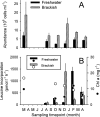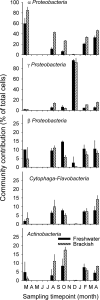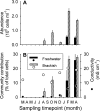Blooms of single bacterial species in a coastal lagoon of the southwestern Atlantic Ocean
- PMID: 17021206
- PMCID: PMC1610279
- DOI: 10.1128/AEM.01089-06
Blooms of single bacterial species in a coastal lagoon of the southwestern Atlantic Ocean
Abstract
We investigated seasonal differences in community structure and activity (leucine incorporation) of the planktonic bacterial assemblage in the freshwater and brackish-water zones of a shallow coastal lagoon of the southwestern Atlantic Ocean. Alphaproteobacteria formed the dominant microbial group in both zones throughout the sampling period. After an intrusion of marine water, members of the SAR11 lineage became abundant in the brackish-water zone. These bacteria were apparently distributed over the lagoon during the following months until they constituted almost 30% of all prokaryotic cells at both sampling sites. At the first sampling date (March 2003) a single alphaproteobacterial species unrelated to SAR11, Sphingomonas echinoides, dominated the microbial assemblages in both zones of the lagoon concomitantly with a bloom of filamentous cyanobacteria. Pronounced maxima of leucine incorporation were observed once in each zone of the lagoon. In the freshwater zone, this highly active microbial assemblage was a mix of the typical bacteria lineages expected in aquatic systems. By contrast, a single bacterial genotype with >99% similarity to the facultative pathogen gammaproteobacterial species Stenotrophomonas maltophilia formed >90% of the bacterial assemblage (>10(7) cell ml(-1)) in the brackish-water zone at the time point of highest bacterial leucine incorporation. Moreover, these bacteria were equally dominant, albeit less active, in the freshwater zone. Thus, the pelagic zone of the studied lagoon harbored repeated short-term blooms of single bacterial species. This finding may have consequences for environmental protection.
Figures





References
-
- Abreu, P. C., C. Odebrecht, and A. Gonzalez. 1994. Particulate and dissolved phytoplankton production of the Patos Lagoon Estuary, southern Brazil: comparison of methods and influencing factors. J. Plankton Res. 16:737-753.
-
- Altschul, S. F., W. Gish, W. Miller, E. W. Myers, and D. J. Lipman. 1990. Basic local alignment search tool. J. Mol. Biol. 215:403-410. - PubMed
-
- APHA. 1995. Standard methods for the examination of water and wastewater. American Public Health Association, Washington, D.C.
-
- Aznar, R., E. Alcaide, and E. Garay. 1992. Numerical taxonomy of pseudomonads isolated from water, sediment and eels. Syst. Appl. Microbiol. 14:235-246.
Publication types
MeSH terms
Associated data
- Actions
- Actions
- Actions
- Actions
- Actions
- Actions
- Actions
- Actions
- Actions
- Actions
- Actions
- Actions
- Actions
- Actions
- Actions
- Actions
- Actions
- Actions
- Actions
- Actions
- Actions
- Actions
- Actions
- Actions
- Actions
- Actions
- Actions
- Actions
- Actions
- Actions
- Actions
- Actions
- Actions
- Actions
- Actions
- Actions
- Actions
- Actions
LinkOut - more resources
Full Text Sources
Molecular Biology Databases

